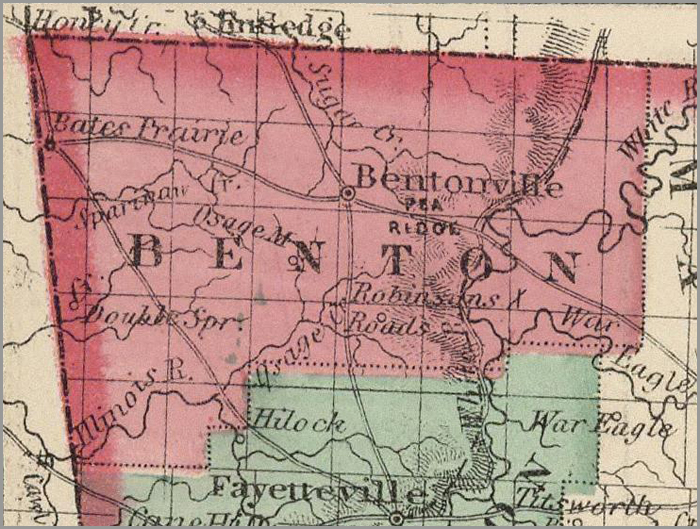Benton County, Arkansas

- Formed: 1836
- County Population 1860: 8,883
- Slave Population 1860: 383
- Civil War Engagements
-Battle of Dunagin Farm, February 17, 1862
-Battle of Pea Ridge, March 7-8, 1862
-Battle of Maysville, October 22, 1862
Image courtesy of the David Rumsey Historical Map Collection
Benton County, Arkansas was originally part of Lovely County; which was formed in 1816. Major William Lovely, a government agent to the Cherokee Indians, purchased land from the Osage as a gift to the Cherokee. The offering was designed to bring peace between the two warring tribes, and became known as “Lovely’s Purchase.” In 1818, Lovely officially received the land in his name, although in reality he had no authority to purchase any land. However, in 1827, Lovely County was officially established and the Cherokee were moved further west. In addition to William Lovely, other early settlers were Adam Batie in 1828, John McPhail in 1830, Martin Mays, after whom Maysville is named, and William Bird Keith. In 1832, Jacob Roller settled in Benton County and opened Roller’s Ridge, which became a whiskey distillery. John Robinson, a Revolutionary War Veteran, settled in Benton County in1835. In 1838, Judge English, Robert Cooper, Lemuel Tynnon, William Reddick, a politician, and Samuel Burks came to the area. John William Walker became the first brick mason in the county, and James, David, and Joseph McKissick started the first apple orchard. The first settlers came mostly from Georgia, Tennessee, Kentucky, North Carolina, and a few from northern states.
Benton County is located on the Missouri-Arkansas border in Northwestern Arkansas. It contains natural mineral springs, copper ore deposits, and soil suitable for growing grains and fruit. Crops include wheat, oats, hops, corn, sorghum, peaches, and apples, and livestock includes dairy cows, sheep, beef cattle, and chickens.
Benton County was officially established out of Lovely County on September 30, 1836. It was named after Senator Thomas Hart Benton from Missouri, who worked on the bill that made Arkansas a state, passed on the same day. Bentonville became the first town in the area. A resident named George P. Wallace, who became the first judge in the county, held the court sessions in his home until the first courthouse could be completed. John William Walker, a brick mason, built the courthouse.
The population continued to grow steadily until the Civil War began. The majority of Benton County residents were supported Arkansas’ decision to secede, not because of pro-slavery sentiment but because they felt more loyal to their state than to the federal government. Several significant battles happened in Benton County. On February 17, 1862, a Skirmish at Little Sugar Creek (Dunagin’s Farm) took place. Confederate troops, under Colonel Louis Hébert, marched north from their camps at Cross Hollows (near present-day Lowell) to assist Price’s Missourians. Hébert and Colonel Henry Little, of the 1st Missouri Brigade, placed their troops across the Telegraph Road near the farm of Rev. Jasper Dunagin. Federal cavalry soon came upon the Southern line. Most of the horsemen veered to either side of the road; but the leading unit did not see the others break away and charged Hébert’s line. Hébert’s men opened fire, killing or wounding 20 men and 60 horses. Federal reinforcements, supported by artillery, arrived and began firing on the Confederates. Having accomplished his mission of delaying Curtis, Hébert withdrew and joined Price’s column. General Sterling Price withdrew from Springfield, Missouri to Arkansas, and joined forces with General Benjamin McCulloch and General James Rains. Union General Alexander Asboth pursued Price, but the Confederate army was able to deter his advance. On the night of March 6, Maj. Gen. Earl Van Dorn set out to outflank the Union position near Pea Ridge. Learning of Van Dorn’s approach, the Federals marched north to meet his advance on March 7. By nightfall, the Confederates controlled Elkhorn Tavern and Telegraph Road. The next day, Maj. Gen. Samuel R. Curtis, having regrouped and consolidated his army, counterattacked near the tavern and, by successfully employing his artillery, slowly forced the Rebels back. Running short of ammunition, Van Dorn abandoned the battlefield. Another Union victory resulted from the Battle of Maysville, October 22, 1862. By December, 1862, Union troops had possession of Bentonville and burned the courthouse to the ground.
Benton County suffered widespread destruction during the war. Their major city, Bentonville, was burned. Most residents loyal to the Union had fled during the war, and many did not return after its end. Railroad construction began in the 1880s, leading to an industry and tourist boom. The mineral springs in the area turned into health resorts at Siloam Springs, Bella Vista, and Sulphur Springs. Towns sprang up around the railroad, including Gravette and Gentry in 1894.
 Browse all collections in Benton County
Browse all collections in Benton County
- Consulted:
- J. Dickson Black, History of Benton County, (Little Rock, AR: Benton County Heritage Committee, 1975).












